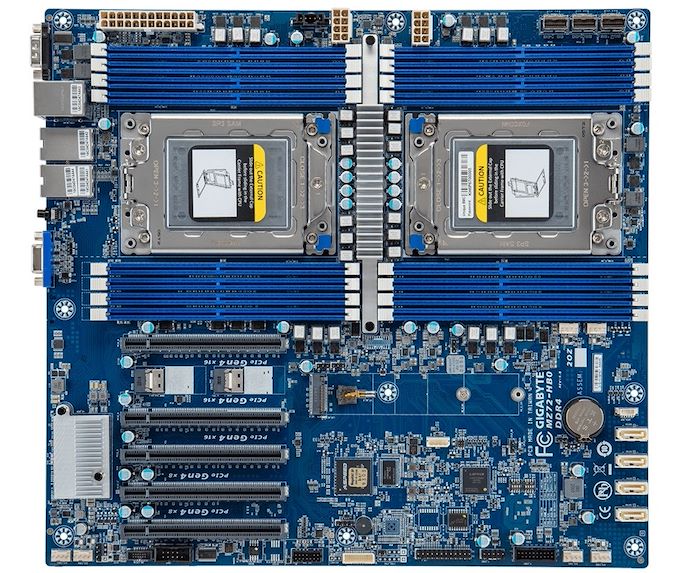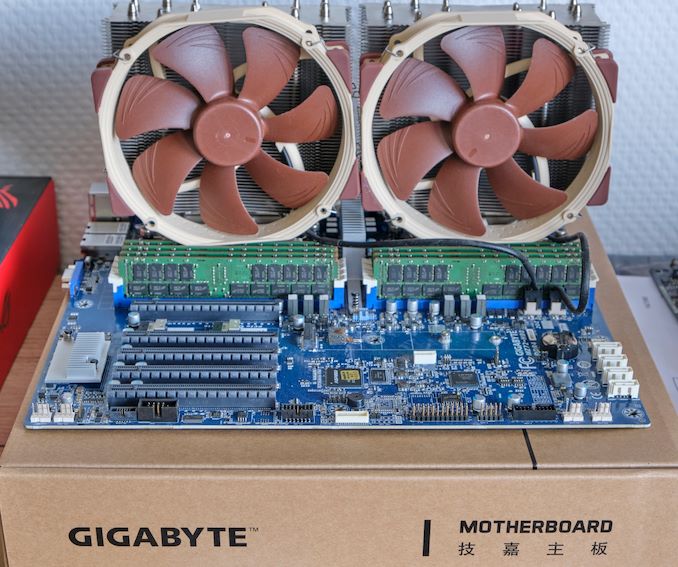It’s been a few months since AMD first announced their new third generation EPYC Milan server CPU line-up. We had initially reviewed the first SKUS back in March, covering the core density optimised 64-core EPYC 7763, EPYC 7713 and the core-performance optimised 32-core EPYC 75F3. Since then, we’ve ben able to get our hands on several new mid and lower end SKUs in the form of the new 24-core EPYC 7443, the 16-core 7343, as well as the very curious 8-core EPYC 72F3 which we’ll be reviewing today.
What’s also changed since our initial review back in March, is the release of Intel’s newer 3rd generation Xeon Scalable processors (Ice Lake SP) with our review of the 40-core Xeon 8330 and 28-core Xeon 6330.
Today’s review will be focused around the new performance numbers of AMD’s EPYC CPUs, for a more comprehensive platform and architecture overview I highly recommend reading our respective initial reviews which go into more detail of the current server CPU landscape:
What's New: EPYC 7443, 7343, 72F3 Low Core Count SKUs
In terms of new SKUs that we’re testing today, as mentioned, we’ll be looking at AMD new EPYC 7443, 7343 as well as the 72F3, mid- to low core-count SKUs that come at much more affordable price tags compared to the flagship units we had initially reviewed back in March. As part of the new platform switch, we’ll cover in a bit, we’re also re-reviewing the 64-core EPYC 7763 and the 32-core EPYC 75F3 – resulting in a few surprises and resolving some of the issues we’ve identified with 3rd generation Milan in our first review.
| AMD EPYC 7003 Processors Core Performance Optimized |
||||||
| Cores Threads |
Base Freq |
Turbo Freq |
L3 (MB) |
TDP | Price | |
| F-Series | ||||||
| EPYC 75F3 | 32 / 64 | 2950 | 4000 | 256 MB |
280 W | $4860 |
| EPYC 74F3 | 24 / 48 | 3200 | 4000 | 240 W | $2900 | |
| EPYC 73F3 | 16 / 32 | 3500 | 4000 | 240 W | $3521 | |
| EPYC 72F3 | 8 / 16 | 3700 | 4100 | 180 W | $2468 | |
Starting off with probably the weirdest CPU in AMD’s EPYC 7003 line-up, the new 72F3 is quite the speciality part in the form of it being an 8-core server CPU, yet still featuring the maximum available platform capabilities as well as the full 256MB of L3 cache. AMD achieves this by essentially populating the part with 8 chiplet dies with each a full 32MB of L3 cache, but only one core enabled per die. This enables the part (for a server part) relatively high base frequency of 3.7GHz, boosting up to 4.1GHz and landing with a TDP of 180W, with the part costing $2468.
The unit is a quite extreme case of SKU segmentation and focuses on deployments where per-core performance is paramount, or also use-cases where per-core software licenses vastly outweigh the cost of the actual hardware. We’re also re-reviewing the 32-core 75F3 in this core-performance optimised family, featuring up to 32 cores, but going for much higher 280W TDPs.
| AMD EPYC 7003 Processors Core Density Optimized |
||||||
| Cores Threads |
Base Freq |
Turbo Freq |
L3 (MB) |
TDP | Price | |
| EPYC 7763 | 64 / 128 | 2450 | 3400 | 256 MB |
280 W | $7890 |
| EPYC 7713 | 64 / 128 | 2000 | 3675 | 225 W | $7060 | |
| EPYC 7663 | 56 / 112 | 2000 | 3500 | 240 W | $6366 | |
| EPYC 7643 | 48 / 96 | 2300 | 3600 | 225 W | $4995 | |
| P-Series (Single Socket Only) | ||||||
| EPYC 7713P | 64 / 128 | 2000 | 3675 | 256 | 225 W | $5010 |
In the core-density optimised series, we’re continuing on using the 64-core EPYC 7763 flagship SKU which lands in at 280W TDP and a high cost of $7890 MSRP. Unfortunately, we no longer have access to the EPYC 7713 so we couldn’t re-review this part, and benchmark numbers from this SKU in this review will carry forward our older scores, also being aptly labelled as such in our graphs.
| AMD EPYC 7003 Processors | ||||||
| Cores Threads |
Base Freq |
Turbo Freq |
L3 (MB) |
TDP | Price | |
| EPYC 7543 | 32 / 64 | 2800 | 3700 | 256 MB | 225 W | $3761 |
| EPYC 7513 | 32 / 64 | 2600 | 3650 | 128 MB | 200 W | $2840 |
| EPYC 7453 | 28 / 56 | 2750 | 3450 | 64 MB | 225 W | $1570 |
| EPYC 7443 | 24 / 48 | 2850 | 4000 | 128 MB |
200 W | $2010 |
| EPYC 7413 | 24 / 48 | 2650 | 3600 | 180 W | $1825 | |
| EPYC 7343 | 16 / 32 | 3200 | 3900 | 190 W | $1565 | |
| EPYC 7313 | 16 / 32 | 3000 | 3700 | 155 W | $1083 | |
| P-Series (Single Socket Only) | ||||||
| EPYC 7543P | 32 / 64 | 2800 | 3700 | 256 MB | 225 W | $2730 |
| EPYC 7443P | 24 / 48 | 2850 | 4000 | 128 MB | 200 W | $1337 |
| EPYC 7313P | 16 / 32 | 3000 | 3700 | 155 W | $913 | |
Finally, the most interesting parts of today’s evaluation are AMD’s mid- to low-core count EPYC 7443 and EPYC 7343 CPUs. At 24- and 16-core, the chips feature a fraction of the maximum theoretical core counts of the platform, but also come at much more affordable price points. These parts should especially be interesting for deployments that plan on using the platform’s full memory or I/O capabilities, but don’t require the raw processing power of the higher-end parts.
These two parts are also defined by having only 128MB of L3 cache, meaning the chips are running only 4 active chiplets, with respectively only 6 and 4 cores per chiplet active. The TDPs are also more reasonable at 200W and 190W, with also respectively lower pricing of $2010 and $1565.
Following Intel’s 3rd generation Xeon Ice Lake SP and our testing of the Xeon 28-core 6330 which lands in at an MSRP of $1894, it’s here where we’ll be seeing the most interesting performance and value comparison for today’s review.
Test Platform Change - Production Milan Board from GIGABYTE: MZ72-HB0 (rev. 3.0)
In our initial Milan review, we unfortunately had to work with AMD to remotely test newest Milan parts within the company’s local datacentre, as our own Daytona reference server platform encountered an unrecoverable hardware failure.
In general, if possible, we also prefer to test things on production systems as they represent a more mature and representative firmware stack.
A few weeks ago, at Computex, GIGABYTE had revealed their newest revision of the company’s dual-socket EPYC board, the E-ATX MZ72-HB0 rev.3.0, which now comes with out-of-box support for the newest 3rd generation Milan parts (The prior rev.1.0 boards don’t support the new CPUs).
The E-ATX form-factor allows for more test-bench setups and noiseless operation (Thanks to Noctua’s massive NH-U14S TR4-SP3 coolers) in more conventional workstation setups.
The platform change away from AMD’s Daytona reference server to the GIGABYTE system also have some significant impacts in regards to the 3rd generation Milan SKUs’ performance, behaving notably different in terms of power characteristics than what we saw on AMD’s system, allowing the chips to achieve even higher performance than what we had tested and published in our initial review.
The Link LonkJune 25, 2021 at 09:30PM
https://ift.tt/3h9lpod
[AnandTech] AMD EPYC Milan Review Part 2: Testing 8 to 64 Cores in a Production Platform - AnandTech
https://ift.tt/2ZDueh5
AMD



No comments:
Post a Comment